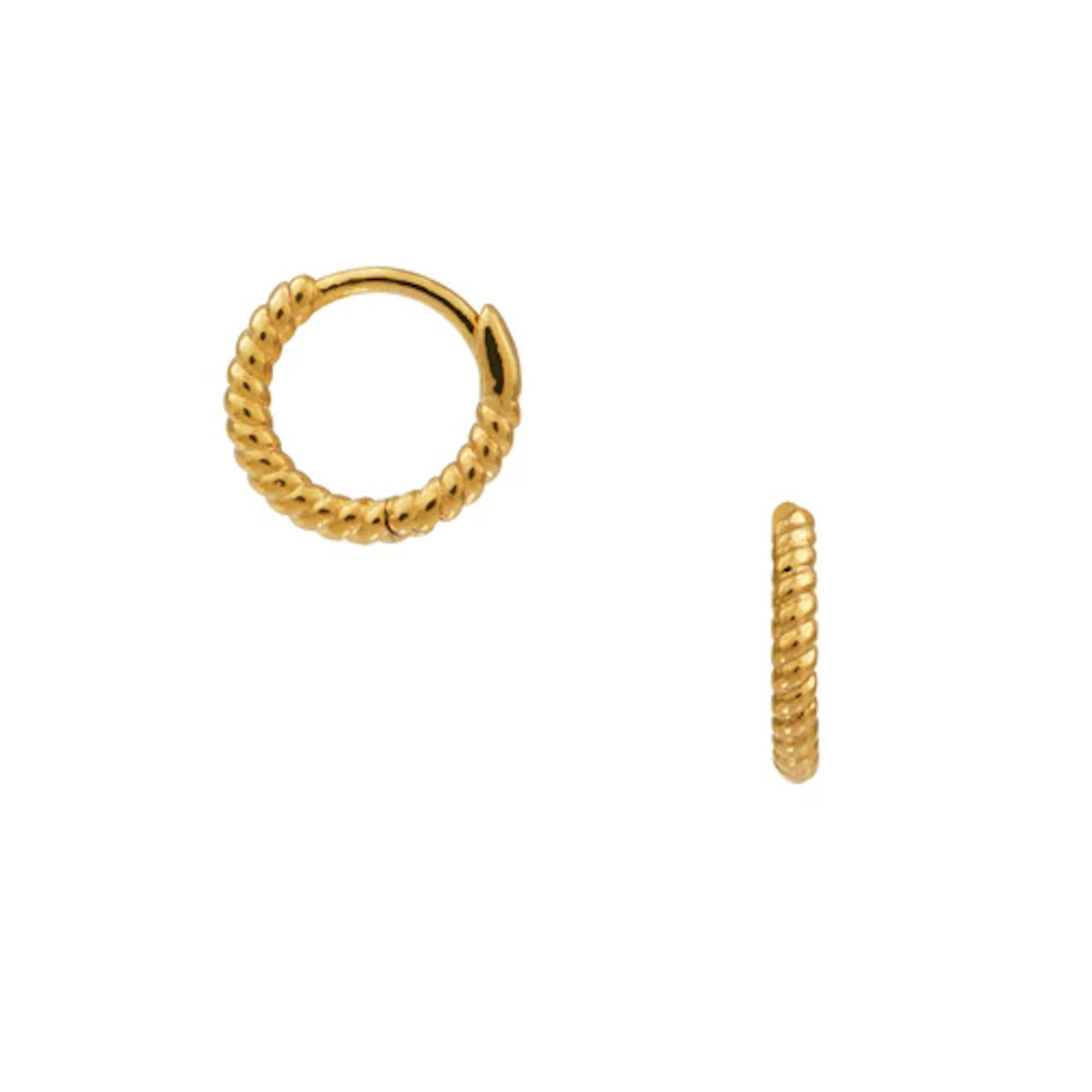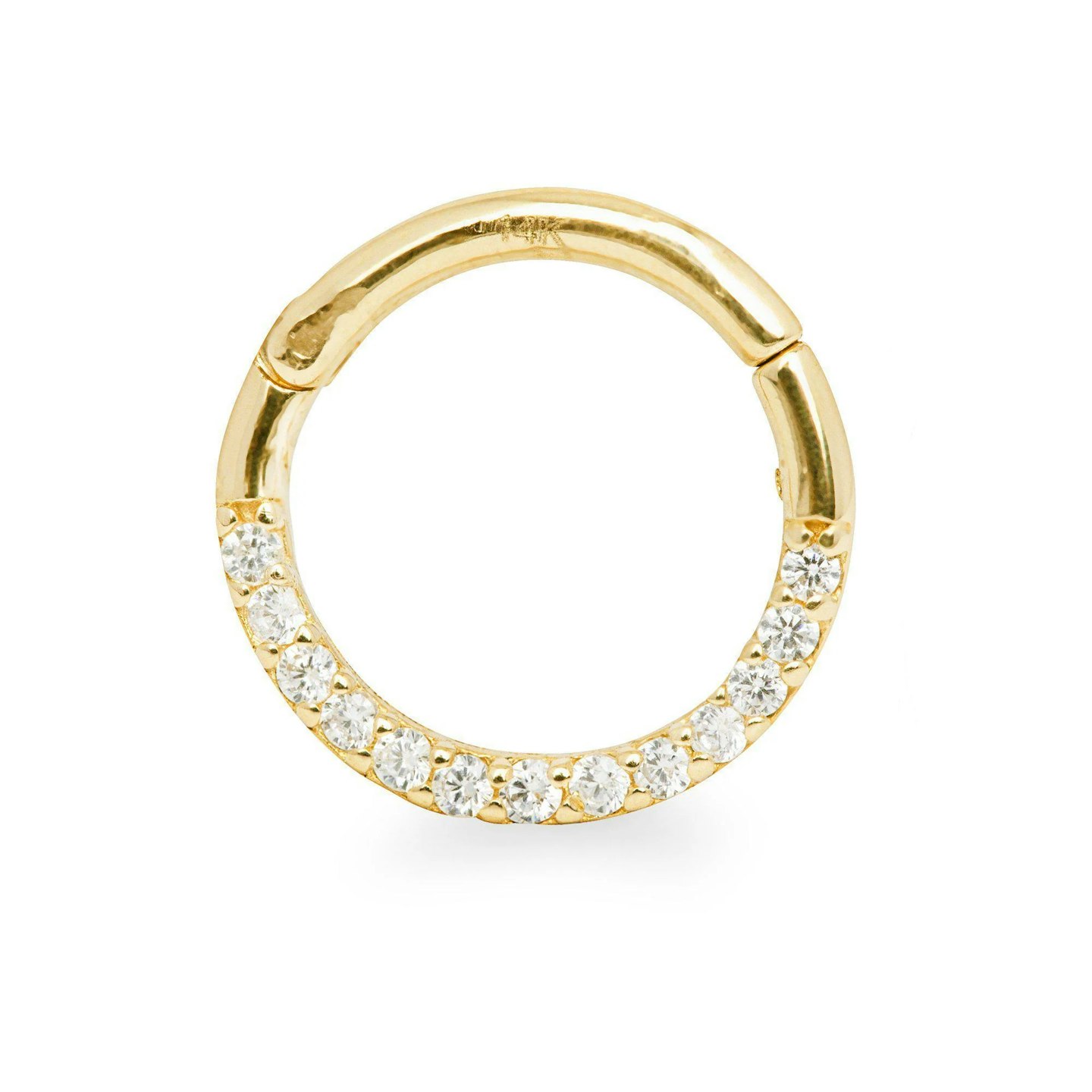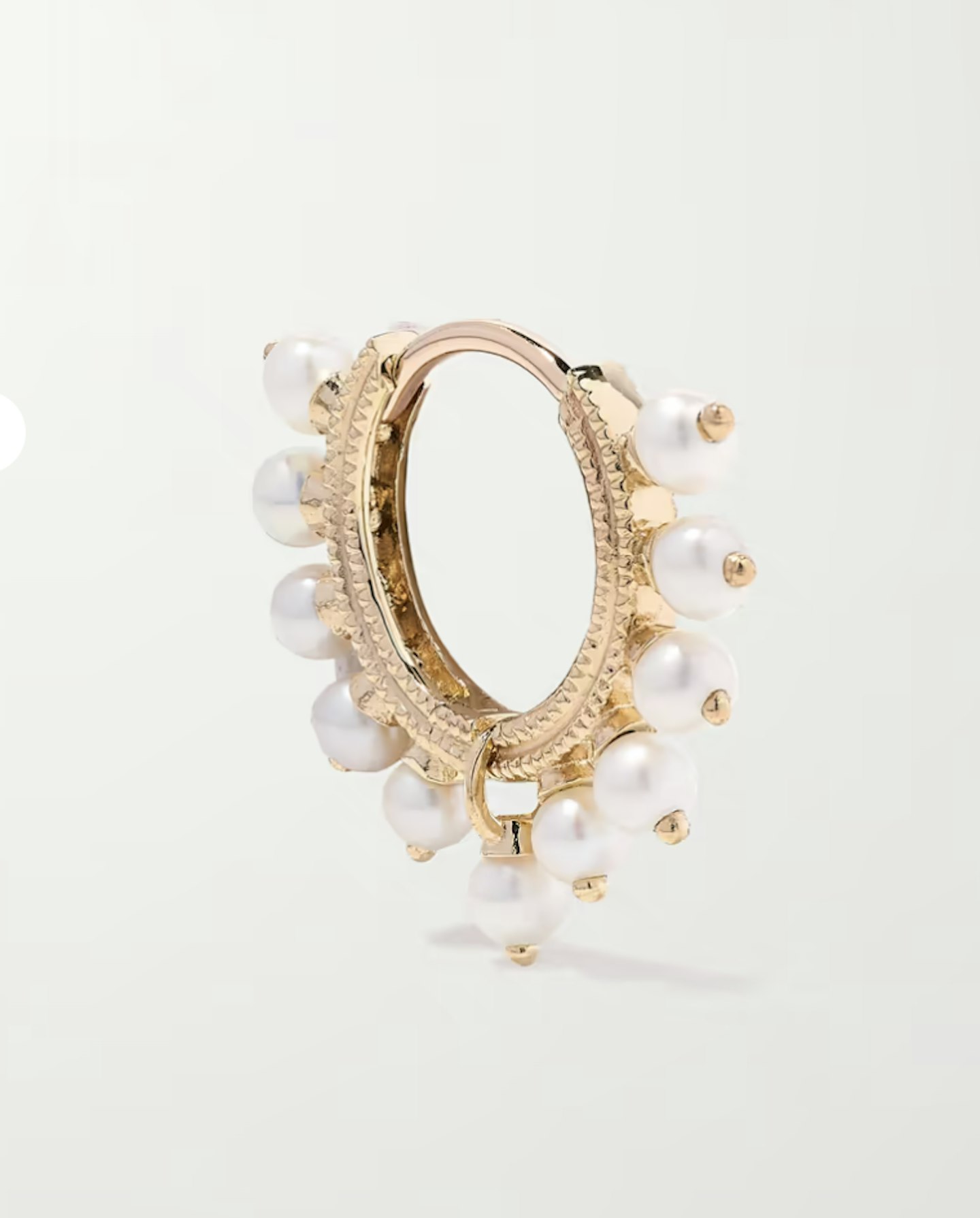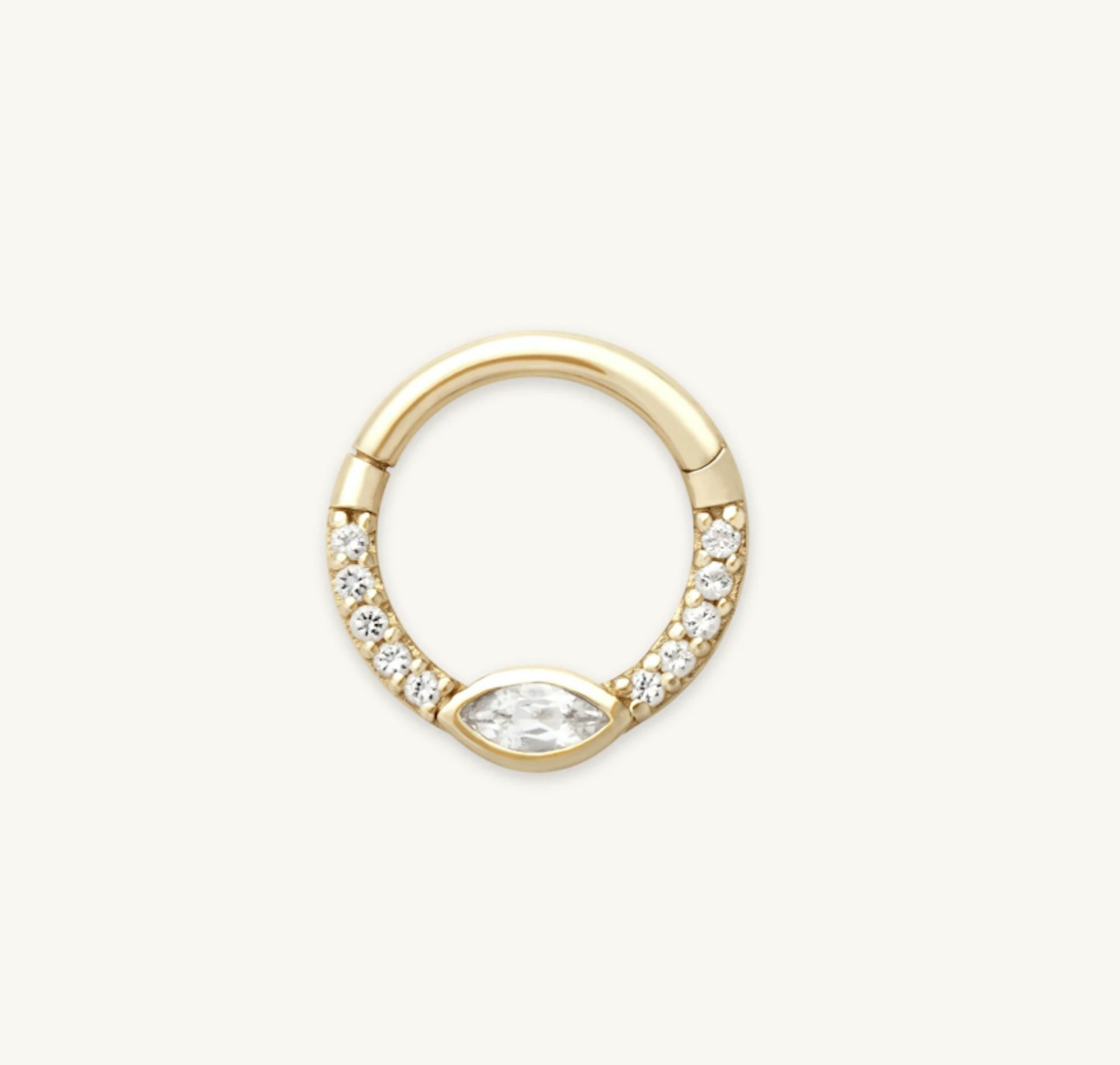Ear piercings. Once you start, you just can’t stop - nothing screams ‘cool-girl’ quite like an expertly curated ear stack, after all. Whether you love the look of a helix piercing or are a devotee to tragus jewellery, there’s numerous piercings that come approved by the fashion-set. One that’s having a moment right now? Aside from the belly button and the nipple, that is. The daith piercing. And it’s hardly a surprise. Pronounced ‘doth,’ not only is the daith piercing aesthetically pleasing, but there’s also growing research to suggest that it may help to relieve migraines. There’s a reason why it’s become one of the most sought after piercings of 2024.
Consider this article your go-to guide for all things daith piercings, from how much it hurts, to healing time, to how soon you can change your jewellery - we’re all impatient, afterall. We’ve enlisted the help of Ara Hall, Expert Piercer at Astrid & Miyu to answer your most Googled questions on daith piercings. Scroll on for the low-down.
What is a daith piercing?
‘A daith is a type of cartilage piercing located in the inner curved fold which sits above the ear canal,’ explains Hall. It's beloved by celebs like Rihanna and Zoe Kravitiz - and even Kylie Jenner has been spotted sporting one on the red carpet. You can usually identify one by looking out for a hoop that hugs the cartilage and sits just behind your tragus, on the inside of the ear.

www.orelia.co.uk
Super dainty, these pretty hoops for Orelia London will contribute to the best ear party going.
Do daith piercings help migraines?
If you’re looking for an excuse to get a daith piercing – the fact that they may just help with headaches, could be one. It’s thought that the position of the piercing (inner curved fold which sits above the ear canal) hits a pressure point which helps to alleviate pressure in the head- essentially how acupuncture works. At the moment, evidence is a little shaky and there’s no official scientific study to back it up, only people’s experiences, so while it may work for some, it mightn't work for others. Dr Thomas Cohn, an interventional pain doctor, weighs in. ‘Recently, some people who have received a daith piercing have coincidentally found improvement with their migraine headaches. It is not universal, and it has not been studied formally. The correlation is based on the success for some people with acupuncture in the same region of the daith piercing. If a person enjoys ear piercing and suffers from frequent headaches, it may be worthwhile to consider getting this spot pierced.’ And even if it doesn’t help, you still end up with a pretty cool piercing.
Pearly queens rejoice- the perfect bridal daith piercingdoes exist.
How much does a daith piercing cost?
Depending where you go, prices for daith piercings will vary - especially if you're choosing more expensive jewellery or getting a piercing in a capital city. Anything upwards of £20 is a good indicator of what to expect. Often, you’ll find that the piercing itself is free and you’ll pay for the jewellery alone ‘At Astrid & Miyu our daith jewellery starts from £35 and ends at £175,’ says Hall. Our top tip? Be sure to find a qualified piercer to achieve the best results and minimise the risk of infection. And, of course, never DIY your piercings at home - you've been warned.

www.wolfandbadger.com
This Diamond Pavé Daith Hoop in 9k Gold would make for the most beautiful gift. We can attest that the diamonds catch the light beautifully.
Daith jewellery
What jewellery materials are suited to a daith piercing? Unsurprisingly, it's all about implant-grade materials that won't degrade with daily wear.
‘It’s important that you choose either implant grade titanium or 14k solid gold,’ explains Hall. ‘Anything lower than 14k solid gold or implant grade titanium is not suited for initial piercings and can be harmful. Many actually have a nickel allergy without realising it so it’s always best to check with your piercer that their jewellery range is hypoallergenic.'
In terms of actual types of daith jewellery, there's several to opt for. Here's some of the most common types below.
Hoop: A hoop style piercing is among the most popular pieces of daith jewellery - they usually take the form of a clicker earring comprised of a clicking mechanism that keeps the earring in place. Look to jewellers like Maria Tash for elegant, dainty hoop jewels.
Barbell: A more hardy, industrial looking piece of daith jewellery is the barbell. This is a metal bar with balls on either end that can be removed to insert into the piercing.

www.farfetch.com
If you only ever own one piece of Maria Tash jewellery then make it this one. It was designed specifically for septum and daith piercings and is adorned with cubic zirconia and pavé-set diamonds. Dreamy.
Pain, Healing time and Aftercare
How painful is a daith piercing? Does a daith piercing hurt? It’s obviously hard to quantify just how much a piercing might hurt - while one might let out a yelp, the other will barely flinch. ‘Depending on the client's pain threshold the scale can range but it’s usually around a 5,’ suggests Hall. ‘Daith piercings are slightly more uncomfortable due to the anatomy being cartilage. You will experience more pressure than pain due to the small area. However the piercing will be over and done with before you know it!’
Spoiler alert - a daith piercing won’t heal super speedily. ‘Daiths can take anywhere from 6 months to over a year to heal,’ advises Hall. ‘Looking after your piercing plays a critical part in healing, we only recommend saline solution twice a day and to thoroughly dry afterwards with either a paper towel or a hairdryer on a cold setting. We don’t recommend sleeping on cartilage piercings so a travel pillow can be handy.’
Fear that it's become infected? Don't fret. Schedule a call with your piercer asap - they can advise you on how best to proceed.
Daith Piercings : Side effects
The least glamorous side of getting a piercing, there's no doubt, but it's important to be aware of the potential side effects that can occur too.
Infection: As with any piercing, there's a real risk of infection. Minimise the risk of inflammation, and ultimately infection, by ensuring you follow the proper aftercare. 'Keeping the area clean at all times will considerably minimise any risks,' says Hall.
Blood Infection: Consider the possibility of a blood infection a real risk - if you don't choose your piercer carefully, that is. More on that further down the page.
Considerable scarring: If you are prone to keloid scars (thick, raised pieces of scar tissue) then a daith piercing mightn't be a suitable option. Consult your doctor first.
When to change your daith piercing
Consider this your warning - don't change your jewellery too soon - you'll need to wait until it's fully healed to do so. You can always pop back to your salon for your piercer to help you, but if you're keen to do it from home be sure to go in with freshly washed hands to prevent infection.
How to pick your piercer
As ever, it's so important to choose a reputable salon when it comes to piercings. The Association of Professional Piercers recommend asking several questions before booking - 'how long your piercer has been piercing, how they learned, and what they do to keep their knowledge-base current – such as taking continuing education courses on anatomy, aftercare, aseptic technique, etc.'
Rachael Martin is Grazia's Junior Beauty Editor where she covers all things beauty, health and wellness


